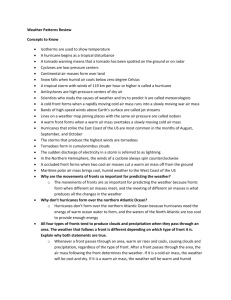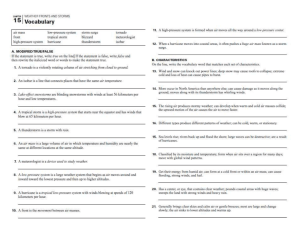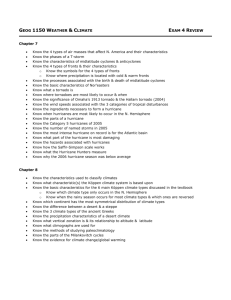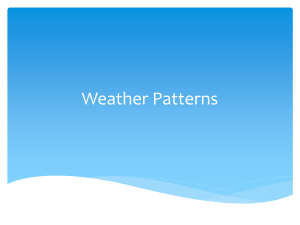Geology Chapter 20 Weather Patterns and Severe Storms
advertisement
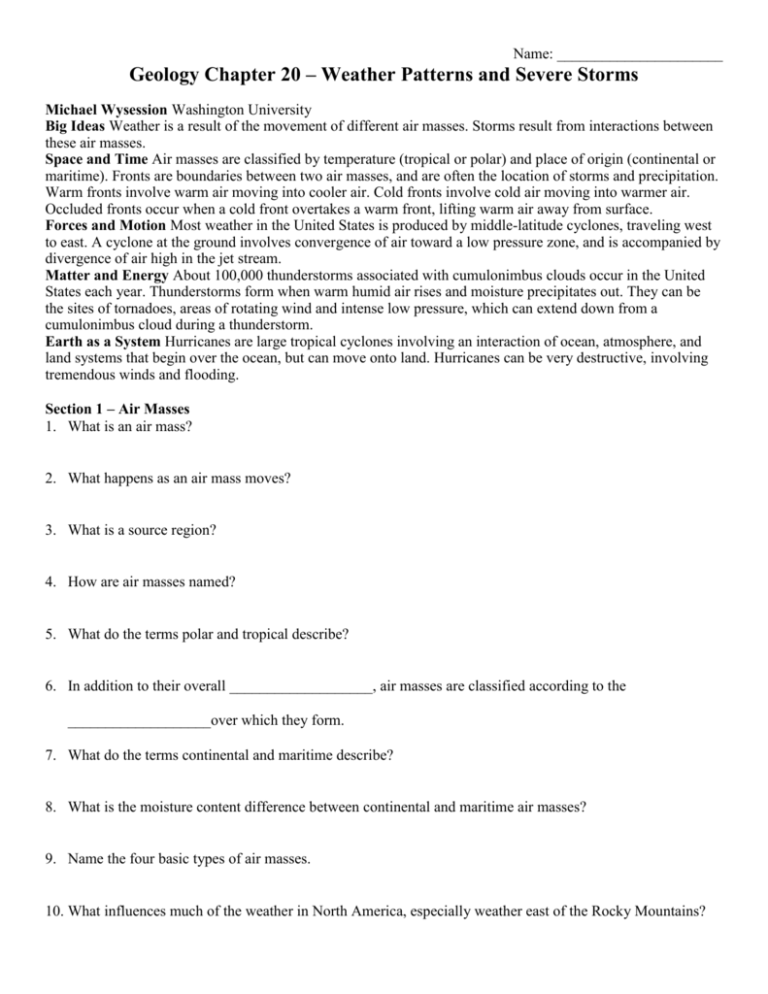
Name: ______________________ Geology Chapter 20 – Weather Patterns and Severe Storms Michael Wysession Washington University Big Ideas Weather is a result of the movement of different air masses. Storms result from interactions between these air masses. Space and Time Air masses are classified by temperature (tropical or polar) and place of origin (continental or maritime). Fronts are boundaries between two air masses, and are often the location of storms and precipitation. Warm fronts involve warm air moving into cooler air. Cold fronts involve cold air moving into warmer air. Occluded fronts occur when a cold front overtakes a warm front, lifting warm air away from surface. Forces and Motion Most weather in the United States is produced by middle-latitude cyclones, traveling west to east. A cyclone at the ground involves convergence of air toward a low pressure zone, and is accompanied by divergence of air high in the jet stream. Matter and Energy About 100,000 thunderstorms associated with cumulonimbus clouds occur in the United States each year. Thunderstorms form when warm humid air rises and moisture precipitates out. They can be the sites of tornadoes, areas of rotating wind and intense low pressure, which can extend down from a cumulonimbus cloud during a thunderstorm. Earth as a System Hurricanes are large tropical cyclones involving an interaction of ocean, atmosphere, and land systems that begin over the ocean, but can move onto land. Hurricanes can be very destructive, involving tremendous winds and flooding. Section 1 – Air Masses 1. What is an air mass? 2. What happens as an air mass moves? 3. What is a source region? 4. How are air masses named? 5. What do the terms polar and tropical describe? 6. In addition to their overall ___________________, air masses are classified according to the ___________________over which they form. 7. What do the terms continental and maritime describe? 8. What is the moisture content difference between continental and maritime air masses? 9. Name the four basic types of air masses. 10. What influences much of the weather in North America, especially weather east of the Rocky Mountains? 11. Describe continental polar air masses. 12. What causes lake-effect snow? 13. Describe maritime tropical air masses. 14. Describe maritime polar air masses. 15. Name two places a maritime polar air mass can originate from. 16. What is a nor’easter? 17. Describe continental tropical air masses. 18. How often do cT air masses affect the weather outside their source regions? 19. What happens when a cT air mass does go outside its source region? Section 2 – Fronts 20. What happens when two air masses meet? 21. What is a front? 22. Where can a front form? 23. What is associated with a front? 24. How are fronts classified? 25. Name the four types of fronts. 26. When does a warm front form? 27. Because of their ___________________rate of ___________________and very low slope, warm fronts usually produce ________________________________ to moderate precipitation over a large ___________________for an ___________________period. 28. When does a cold front form? 29. Compare cold fronts with warm fronts in terms of steepness and speed. 30. What can the forceful lifting of air along a cold front lead to? 31. Occasionally, the flow of air on either side of a front is ___________________toward the ___________________air mass nor toward the ___________________air mass, but almost ___________________to the line of the front. In such cases, the ___________________position of the front does not move, and a ___________________front forms. 32. What type of weather is associated with stationary fronts? 33. What happens when an active cold front overtakes a warm front? 34. The weather associated with an occluded front is generally ___________________. 35. What are middle-latitude cyclones? 36. How does the air in these weather systems move? 37. More often than not, air high up in the ___________________fuels a ___________________-latitude cyclone. 38. A close relationship exists between cyclones and anticyclones. The surface air that feeds a ___________________generally originates as air flowing out of an ___________________. Section 3 – Severe Storms 39. What is a thunderstorm? 40. What do thunderstorms frequently produce? 41. At any given time how many thunderstorms are there on Earth? 42. Where are the greatest numbers of thunderstorms occurring? 43. When do thunderstorms form? 44. Briefly describe the three stages of thunderstorm development. 45. What are tornadoes? 46. What is the vortex of a tornado? 47. About how many tornadoes are reported each year? 48. When is the greatest frequency? The least frequency? 49. Most ___________________form in association with severe ___________________. 50. An important process in the formation of many tornadoes is the development of a ___________________. 51. What is a mesocyclone? 52. The low ___________________within a tornado causes air near the ground to rush into a tornado from all __________________. 53. Name one scale used to estimate tornado intensity. 54. How is a rating on this scale determined? 55. What is the SPC and what is its mission? 56. What is the difference between a tornado watch and a tornado warning? 57. What are hurricanes? 58. List three other names for hurricanes. 59. Why are hurricanes becoming a growing threat? 60. Where do most hurricanes form? 61. A hurricane is a heat ___________________that is fueled by the energy given off when huge quantities of ___________________vapor ___________________. 62. When do hurricanes develop most often? 63. What is the eye-wall? 64. Where do the greatest wind speed and heaviest rainfall occur in a hurricane? 65. Where is the eye of a hurricane? 66. How is the intensity of a hurricane described? 67. The most devastating damage from a hurricane is caused by ________________________. 68. What is a storm surge? 69. List four ways a hurricane can be weakened.
